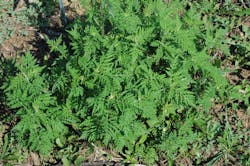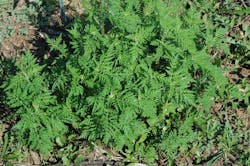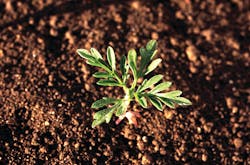Why is common ragweed a problem?
Common ragweed is an extreme weed — thriving in extreme environments and making a home for itself in every state, except Alaska.
Common ragweed has shown resistance to a variety of herbicide groups, including ALS inhibitors, Photosystem II inhibitors, EPSP synthase inhibitors and PPO inhibitors. This makes timely identification and effective control strategies exceedingly important for utility companies and their vegetation management partners.
What does common ragweed look like?
Mature common ragweed plants can be easy to spot, standing over 6 feet tall with fibrous and shallow root systems. Mature plants are bushy and feature hairy stems as well as alternating leaves. Each individual plant can produce between 32,000 to 62,000 seeds.
Seedlings emerge from May to June with dark-green, thick and spatula-shaped leaves, often featuring small purple spots on their edge. The plant’s first true leaves are hairy on both sides, and already have a dissected form of adult leaves.
How to effectively control common ragweed
Common ragweed grows well in areas with sparse vegetation and in soil with low fertility. Therefore, when beneficial plant species thrive and the soil is well managed, common ragweed risk is reduced.
Using selective herbicide applications as part of an Integrated Vegetation Management (IVM) strategy can improve results achieved by mechanical mowing, leading to sustainable control and fewer maintenance requirements. This strategy also aligns with a grass-friendly approach that helps prevent the establishment of incompatible trees and brush species throughout utility right-of-way corridors.
Added benefits of controlling undesirable plant species like common ragweed also include:
- Improved ROW accessibility
- Habitat biodiversity for native wildlife
- Risk mitigation for infrastructure damage and lapses in electrical service
Common ragweed also can develop throughout utility substations and other areas where bareground results are required. To achieve total vegetation control in these areas with a preemergence herbicide application, mix TerraVue® herbicide at 2 to 2.85 oz per acre with a compatible tank-mix partner, such as Dimension® specialty herbicide to broaden the weed spectrum and enhance grass control.
For postemergence applications in areas where bareground results aren’t necessary, TerraVue herbicide should be applied after perennial grasses are well established. TerraVue herbicide may suppress certain established grasses, such as smooth bromegrass, when plants are stressed by adverse environmental conditions. Plants should recover with the onset of environmental conditions and upon release from weed competition. Tall fescue, orchardgrass, timothy and annual ryegrass are tolerant of 2.85 oz per acre of TerraVue herbicide once plants have developed three collared leaves.
More information regarding best practices for controlling incompatible vegetation throughout utility ROW corridors and adjacent land can be found at Utility.VegetationMgmt.com.
™ ® Trademarks of Corteva Agriscience and its affiliated companies. Under normal field conditions, TerraVue® is nonvolatile. TerraVue has no grazing or haying restrictions for any class of livestock, including lactating dairy cows, horses (including lactating mares) and meat animals prior to slaughter. Label precautions apply to forage treated with TerraVue and to manure and urine from animals that have consumed treated forage. TerraVue is not registered for sale or use in all states. Contact your state pesticide regulatory agency to determine if a product is registered for sale or use in your state. State restrictions on the sale and use of Dimension® apply. Consult the label before purchase or use for full details. Always read and follow label directions. © 2023 Corteva.
Sponsored By:



